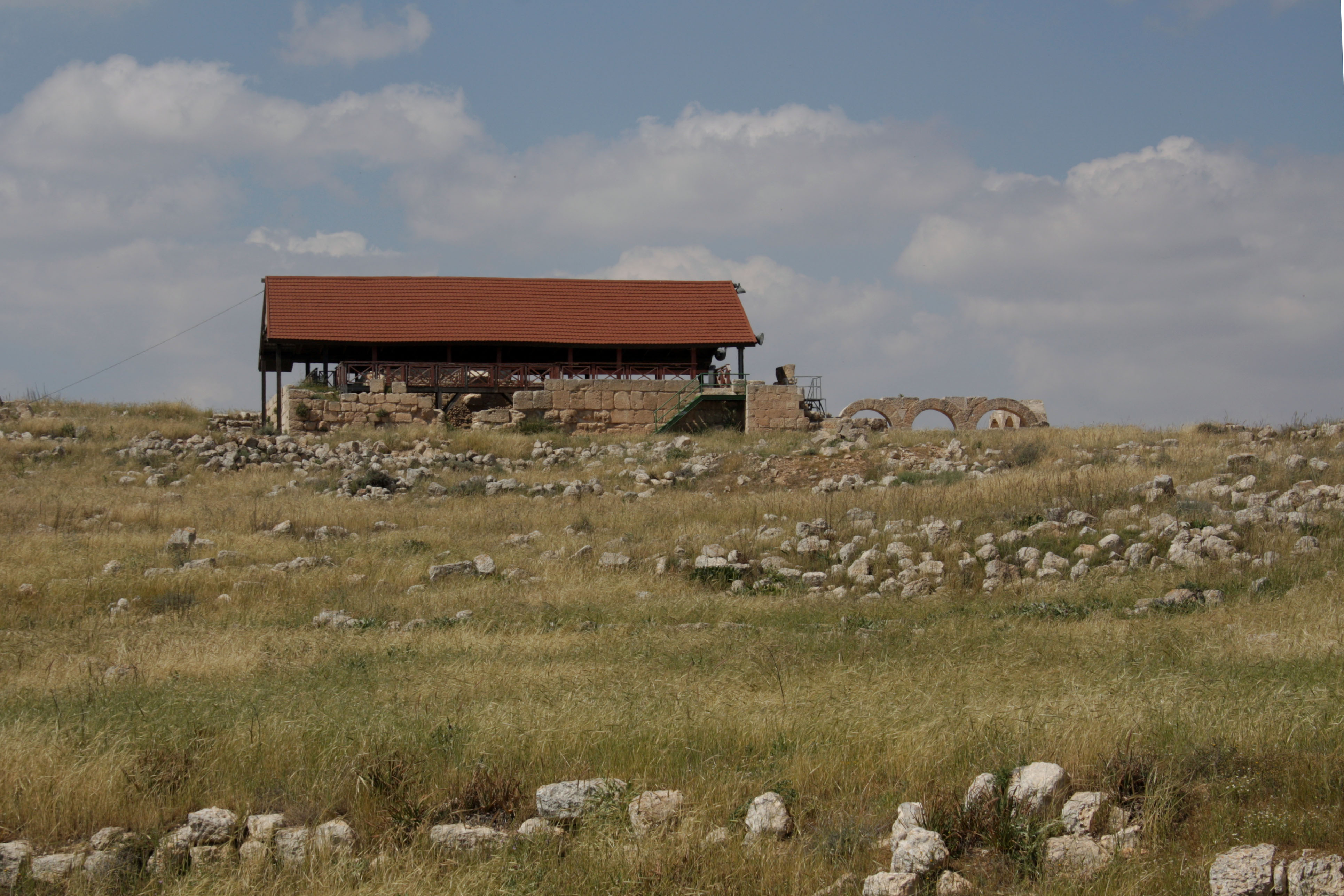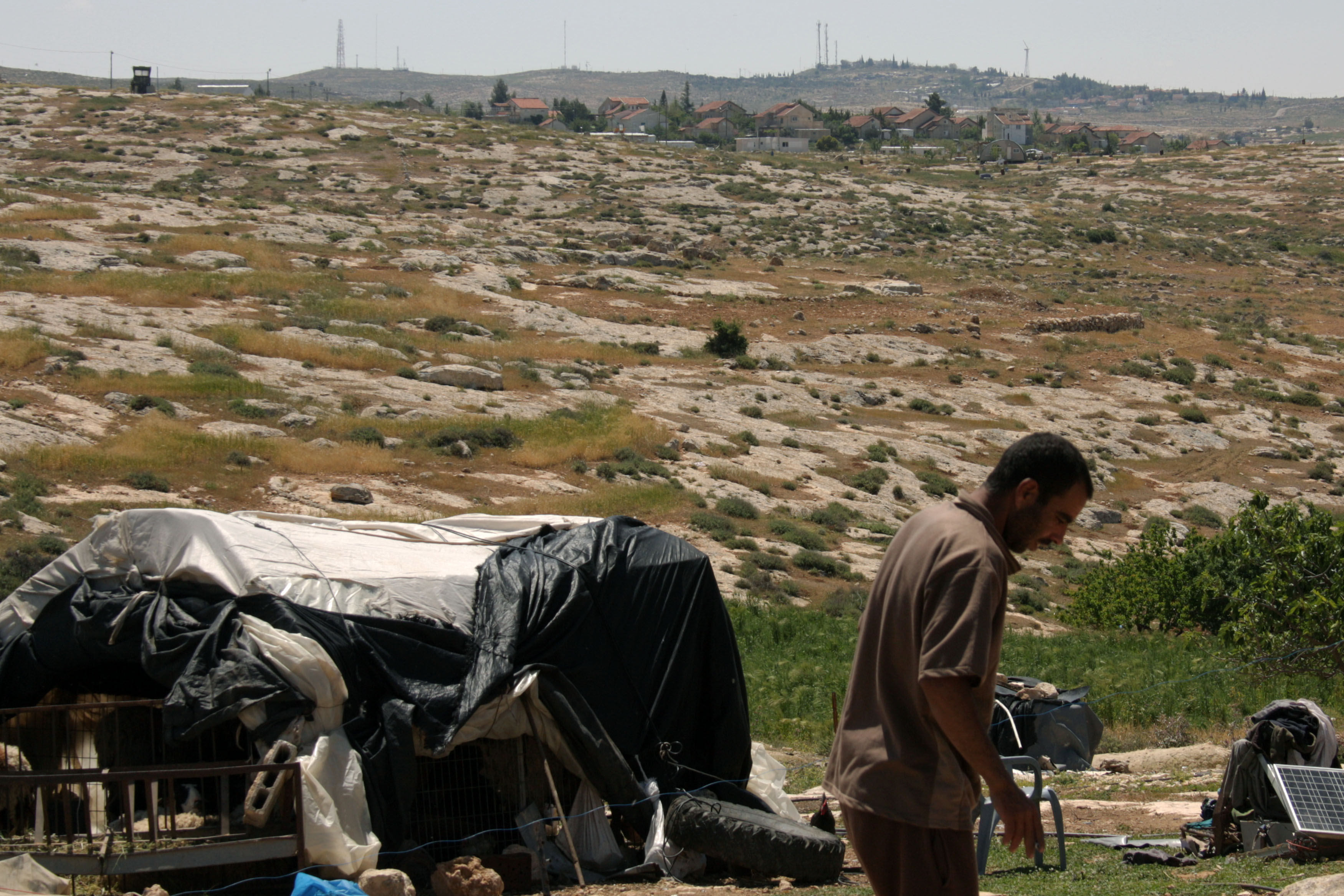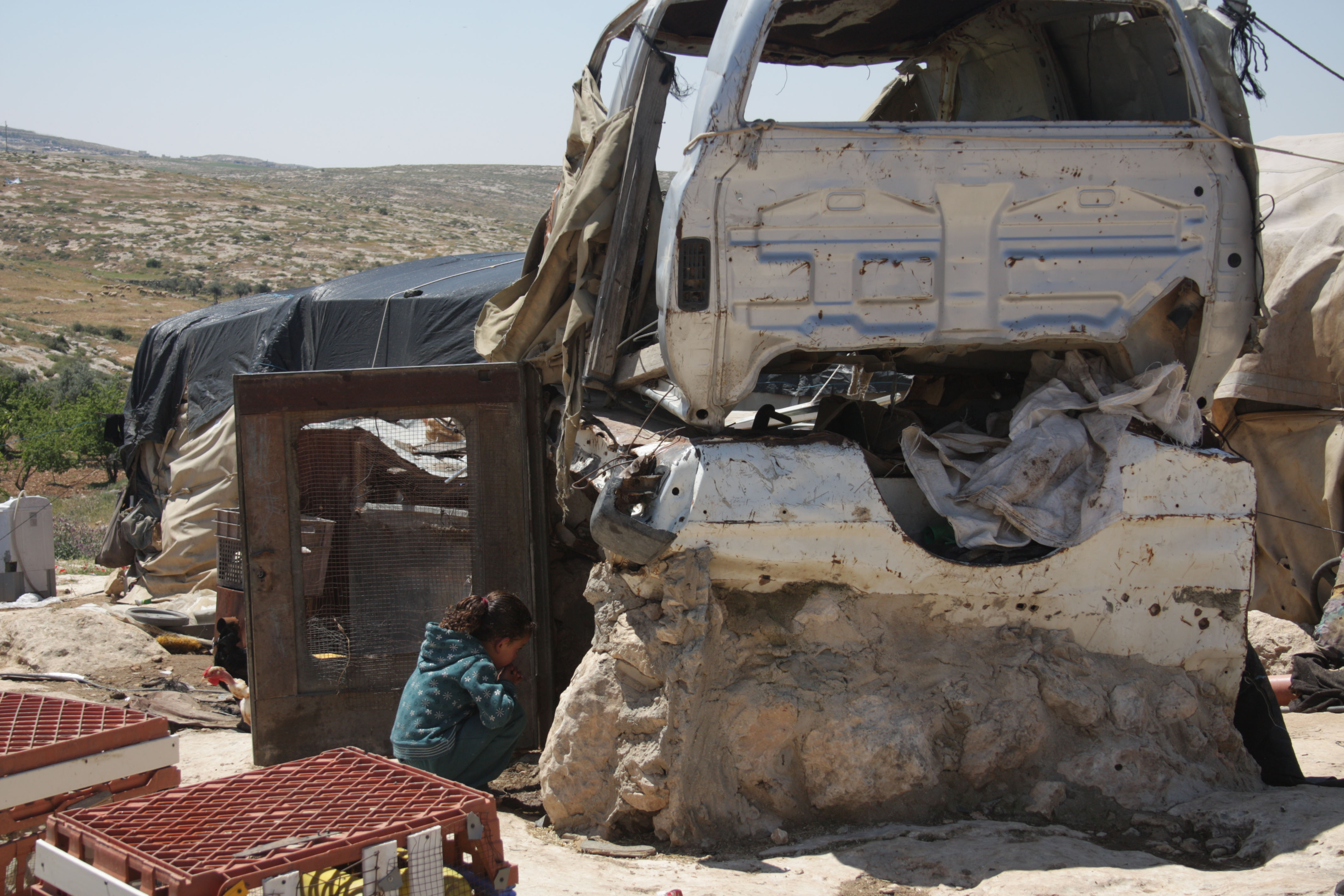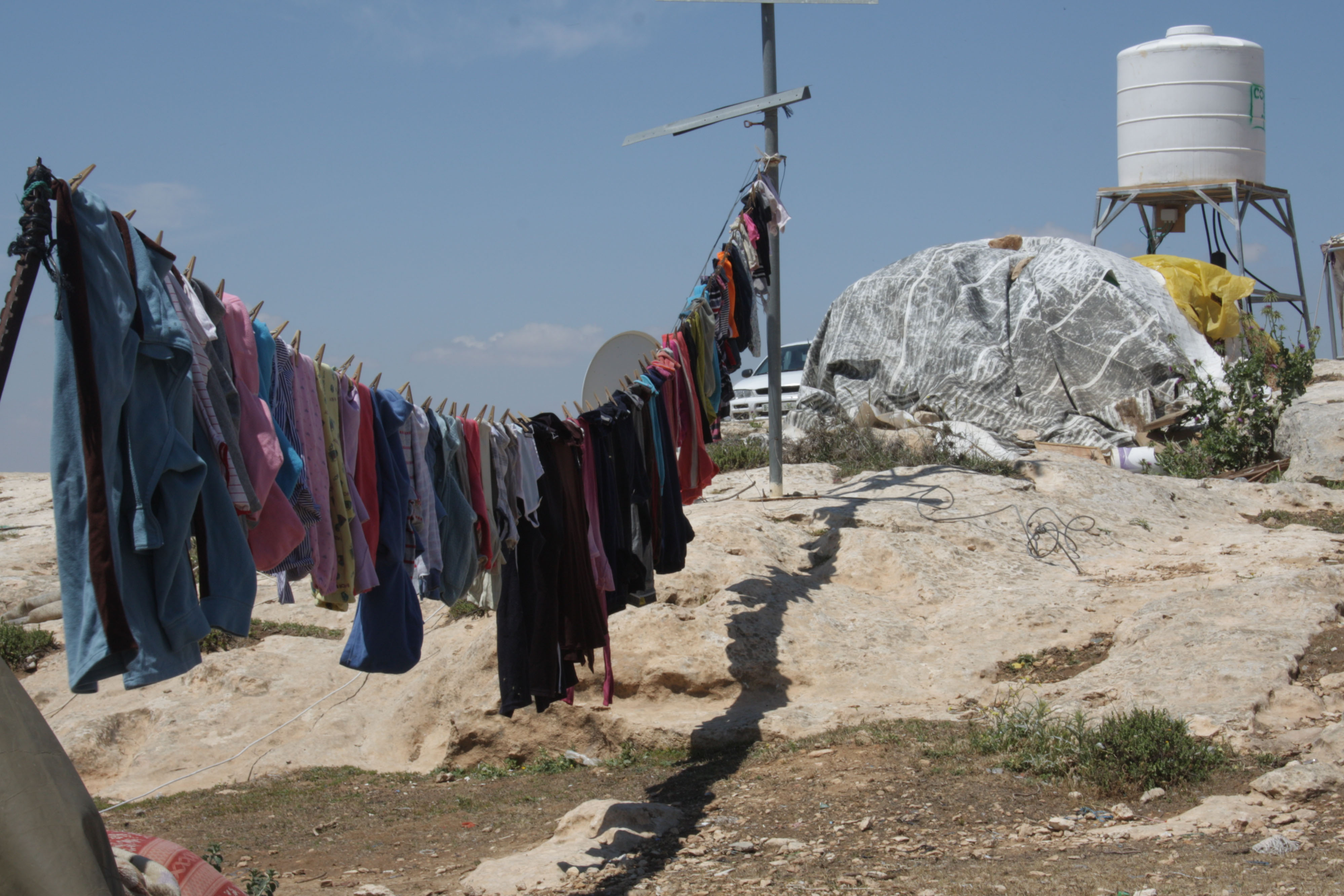Archaeology of a dispossession

On the way to the Palestinian village of Susiya in the South Hebron Hills, the dirt road leading to the village flanks a hill dotted with scattered stones. At the top of the hill is the only discernible, standing structure: an ancient synagogue that later became a mosque. "This used to be our village, I was born there," says 29-year-old Abed Nawaja'a.
The piece of land he is pointing to lies beyond barbed wire, watched over by an army base. The scattered stones are all that remains of Old Susiya. In 1986, the land on which the village had existed since at least the 1830s was expropriated to make room for an archaeological park; its residents relocated to their agricultural lands less than a kilometre away. Palestinians, including the villagers themselves, are not allowed in the site.
At the end of March 2015, the Israeli daily "Haaretz" reported that the government sought permission from the High Court of Justice to demolish the village of Susiya and relocate its residents to the nearby town of Yatta, stating in a response to a petition filed on behalf of the village that "there was no historic Palestinian village at the archaeological site there; that the village consists of only a few seasonal residences for a few families; and the land is necessary for the continuation of archaeological work."
Residents told Qantara.de that the government intends to expand tourism facilities at the site to incorporate the village. A spokesperson for the Coordinator of Government Activities in the Territories (COGAT) told Qantara.de that "as part of the effort for developing the archaeological site at Susiya, works are continuously being done for the preparation of trails, restorations of historical articles found at the site, conservation of the site and its preparation for receiving the visiting public."

An ongoing history of loss
"We were farmers before and we are farmers now," says Mohammad Ahmad Nawaja'a, Abed's father. He was born across the green line, but his family was displaced to Susiya in 1948, where they owned land that they would spend their summers harvesting.
At first glance, time in Khirbet Susiya goes by unacknowledged. Approximately 350 people live here, harvesting olives, herding sheep, growing crops, beekeeping. But time also brought a belt of national-religious settlements to the Hebron Hills as well as frequent harassment and violent attacks against Palestinians, their crops, olive trees and homes, widely documented by various human rights organisations. It brought the red-roofed houses that can be seen across the valley, when the Jewish settlement of Susiya was founded in 1983.
"This is where most of our problems come from," says Mohammad Nawaja'a. All 100 or so structures in the village were served with demolition orders, and the village was destroyed or partly destroyed several times.
Behind the legal push to raze Khirbet Susiya is a right-wing organisation called Regavim, concerned with monitoring what they call illegal construction in Area C. In February 2012, together with the settlement of Susiya, the organisation filed a petition calling on the authorities to implement the demolition orders.
The Palestinian village and the settlement are both in what the Oslo Accords designated as Area C, the 60 per cent of the West Bank under full Israeli control.
Roofs in Khirbet Susiya are, at best, made of tin. Because the Israeli Civil Administration never approved a master plan for the village, permanent structures were never allowed. The courts have frozen the demolitions, but residents are prohibited from building any new structures.
"One time I made a small shelter for my chickens, 1x1 metre, for 6 or 7 shekels," says Azzam Nawaja'a. "The settlers came, took a photo and sent it to the lawyer, who called me to say that if I didn't destroy it myself, I'd have to pay 5,000 shekels (€1,200) for it to be destroyed by the army." Some of Azzam's sons and daughters have already left the village to live in the city. "There is no space, where should they go?"
"25 years in the courts, for nothing," says Azzam.

Discriminatory planning under fire
Five attempts at preparing a master plan for the village ended in rejection. "We are involved in rule of law issues, in trying to get the government to act where illegal building is taking place, all over Israel and all over Area C," said Ari Briggs, director of international relations at Regavim. Their work, however, focuses on buildings by and for Palestinians, including structures erected by EU donors.
According to Israeli human rights organisation B'Tselem, the Civil Administration has to date refused or avoided approving any master plan for over 90% of Palestinian villages located entirely within Area C. Meanwhile, OCHA (the UN Office for the Coordination of Humanitarian Affairs) figures show that only last year, 601 Palestinian structures were demolished in the West Bank and East Jerusalem, displacing 1,215 people.
"They only build illegally because they aren't allowed to build, and they do not have electricity and water because the civil administration doesn't allow them to have electricity and water," said Avital Sharon, a lawyer for Rabbis for Human Rights who has been working on the Susiya case.
In a document published two weeks ago, Amnesty International slammed the planning regime in the West Bank as discriminatory, arguing that it "facilitated the planning, construction and expansion of illegal Israeli settlements," and that the "formal denial of participation in planning for an entire population, coupled with the establishment of a parallel planning system for Israeli settlements that explicitly discriminates in favour of another population whose very presence living in the territory in question violates international law, is unique globally."
A recent report (Under the Radar, 2015) by Israeli NGO Yesh Din argues that since 2011, legalising settlements has been the "unofficial policy" of the Netanyahu government, showing that a quarter of outposts (illegal under Israeli as well as international law) in the West Bank have either been approved or are in the process of being approved by the government.

Archaeology and politics
In 2010, the Susiya archaeological park was designated a National Heritage Site, one of six Israeli sites located in the West Bank. Netanyahu had invested $190 million in the project. Some sites such as Susiya and Tel Shiloh are managed by settler foundations.
"Archaeology is very significant to justifying settlement activity, and this is why the Netanyahu government made this investment," Hamed Salem, professor of History and Archaeology at Birzeit University, told Qantara.de.
In the eighth century, a mosque was built on the remains of the ancient synagogue in old Susiya. But a visit to the site today provides very little information about the non-Jewish history of the place.
"What we know from the excavations is that it used to be a large village from the second to the thirteenth century. We definitely know about the presence of a Jewish population in Susiya from the fourth to the sixth century. Then we see a change in the population," said Yonathan Mizrachi, an Israeli archaeologist part of a group called Emek Shaveh, which challenges the political use of archaeology. "Archaeologists also found inscriptions in Arabic which were never published but are believed to have been part of the mosque."
"The story of the village didn't end in the eighth century. The historical narrative cannot be only about one nation, or one period, or one religion."
Ylenia Gostoli
© Qantara.de 2015